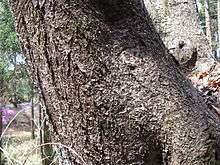Prunus verecunda
| Prunus verecunda | |
|---|---|
 | |
| The bark of a P. verecunda tree | |
| Scientific classification | |
| Kingdom: | Plantae |
| (unranked): | Angiosperms |
| (unranked): | Eudicots |
| (unranked): | Rosids |
| Order: | Rosales |
| Family: | Rosaceae |
| Genus: | Prunus |
| Species: | P. verecunda |
| Binomial name | |
| Prunus verecunda | |
| Synonyms[1] | |
Prunus verecunda is a native of Korea and Japan.[1] It generally has autumnal leaves of reddish-brown or crimson red colour. It has flowers of bright yellow-white colors.[2]
Biochemistry
In this species various new flavonoid compounds have been found. The compounds are pinocembrin-5-glucoside (5,7-dihydroxyflavanone 5-glucoside), geinstein (5,7,4'-trihydroxysoflavone), prunetin (5,4' dihydroxy-7-methoxyflavanone) and pinocembrin (5,7-dihydroxyflavanone) were found on September 6, 1956.[3]
Habitat
This species is a native of middle Japan, where it is commonly distributed into the mountainous regions.
References
- 1 2 "Prunus verecunda". Germplasm Resources Information Network (GRIN). Agricultural Research Service (ARS), United States Department of Agriculture (USDA). Retrieved 23 January 2018.
- ↑ Wakita Yoichi; Sato Takao; Takiya Mika (2004). "Bloom characteristic of Kasumizakura (Prunus verecunda Koehne)". Bulletin of the Hokkaido Forest Experiment Station (in Japanese). Japan. 41: 26–32. ISSN 0910-3945.
- ↑ Hasegawa, Masao; Shirato, Teruo (20 January 1957). "Flavonoids of Various Prunus Species. V. The Flavonoids in the Wood of Prunus verecunda". Journal of the American Chemical Society. 79 (2): 450–452. doi:10.1021/ja01559a059.
| Wikispecies has information related to Prunus verecunda |
| Wikimedia Commons has media related to Prunus verecunda. |
This article is issued from
Wikipedia.
The text is licensed under Creative Commons - Attribution - Sharealike.
Additional terms may apply for the media files.